In conversation: Logan Maxwell-Hagege on the new American West
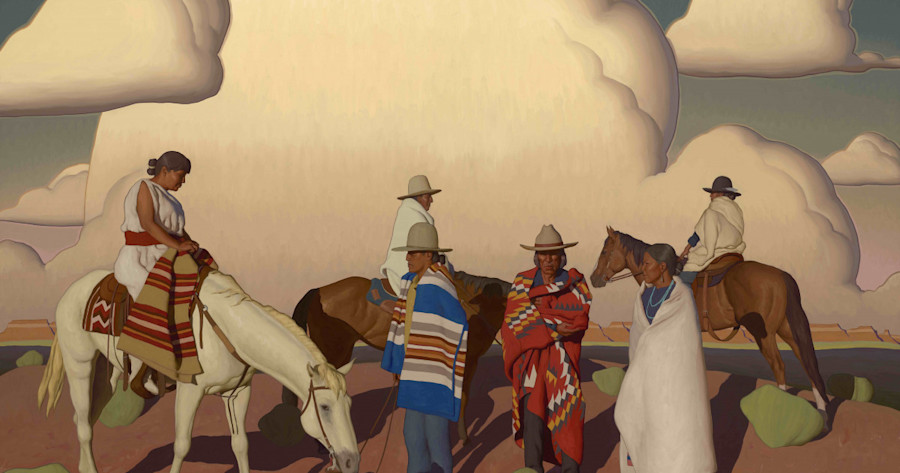
The American West has long been a silent muse for artists to prescribe a particular idealism onto canvas. No other environment is so representative of the success, conflict and disasters of its own history in such interpretive detail; and yet no other landscape has evolved and eroded so much in the time since its golden age.
Logan Maxwell-Hagege's observations of a new American West are applied on canvas as unique, if not revelatory works pitting traditional realism in abstract surroundings. Framed within enormous blocks of light, colour and cloud, his subjects (from rodeo cowboys to Native American communities) are realised with a level of detail that leaves their stories open to vivid interpretation. On the opening of a new show 'Dear Old Western Sky' he tells us what to look out for.
Logan, where are you at the moment?
We just moved to a little town called Ojai, about an hour north of LA. Part of the move was so I could build a studio on the property and work from home instead of having a separate space away from home. We broke ground about two weeks ago and we're hoping it should be complete in the next three months.
What does the studio look like?
Well, lately I’ve just been working out of a two-car garage (laughs). A studio space is helpful, just to have more physical space. I work on several paintings at the same time so I might work on one for a little bit then move on to something else. This painting I’m currently working on is drying, so I’ll go off and think about it then come back with fresh eyes.
Looking back, I've had all kinds of studios from huge warehouse spaces to a bedroom in an apartment. It's less about how grand a space is or how special it is, but more about the purpose of a space to have the room to get back and be able to look at paintings from a proper distance, to store frames for the paintings, have a packing and shipping area, painting storage, etc. So I'm just kinda making my current space work for now.
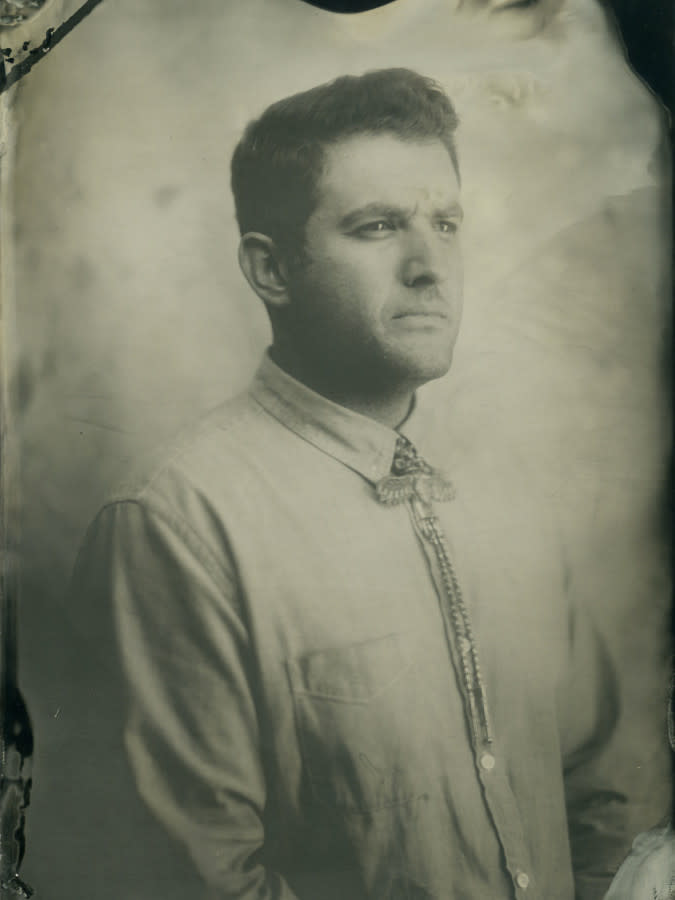
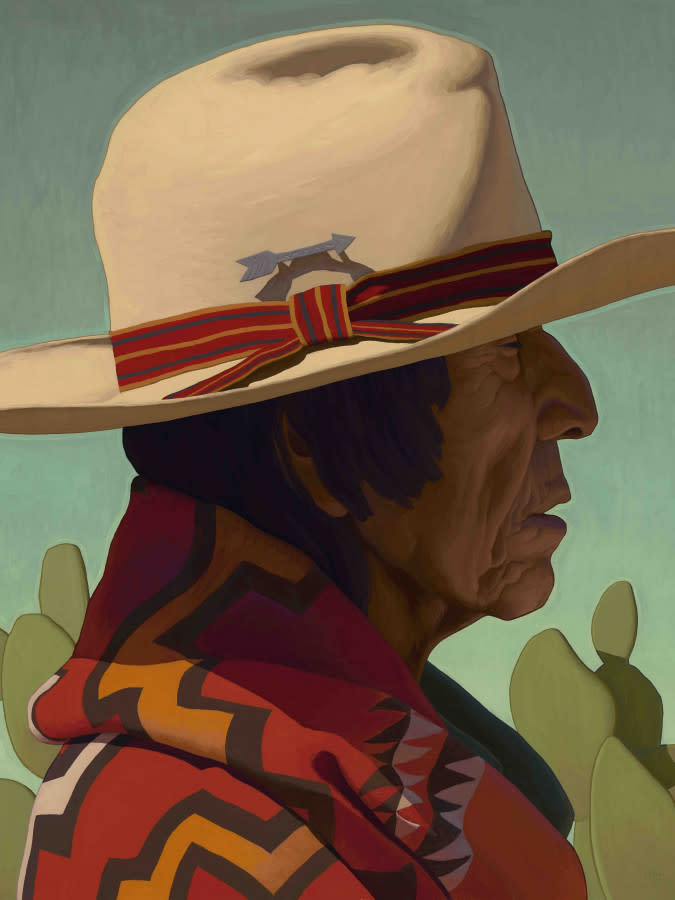
We're talking just as you're finishing up a collection for showing. What's that moment like for you?
It’s really satisfying. I’m pretty good at knowing when a painting is finished. I don’t usually come back and tweak things. It’s definitely a good feeling to complete paintings and stack them up for showing.
Generally I work to finish as many paintings as I can, and then as it gets closer to a show I’ll set everything out, look at what I’ve completed over the last year or so, then look at the show as a cohesive whole and see if it makes sense. If something doesn’t make sense I’ll pull it out of the show and use it for another exhibit, or perhaps not show it at all. For this show there were two or three paintings I cut along the way. I finished them and had let them sit, but I already knew they were not going to work. It’s part of the process and I try not to overthink it because it’s a mind-fuck if I put too much pressure on myself. So I just try to work as much as I can, get as much done as possible, and then piece it all together; all the while also having this kind of theme and the idea of a show in the back of my mind. I try to just kind of let myself be free about it.
Your last book Desert Survey was classified as a ‘Survey of the American West’ which I thought was a great description of your work. What position are you surveying from—active participant or outside observer?
It's a combination of both. I try to really immerse myself in my surroundings when I’m out in the American West. But at the same time I’m studying nature, so when I’m taking photographs or painting on-location I’m trying to study it with wonderment. Almost like through a child’s eyes where I’m surprised by things and still amazed by what I see. My paintings are representative of the world but they're also their own world, so I try to leave a little bit of room for that and let myself be excited by what I'm seeing.
It's an image and a memory that is burned into my brain.
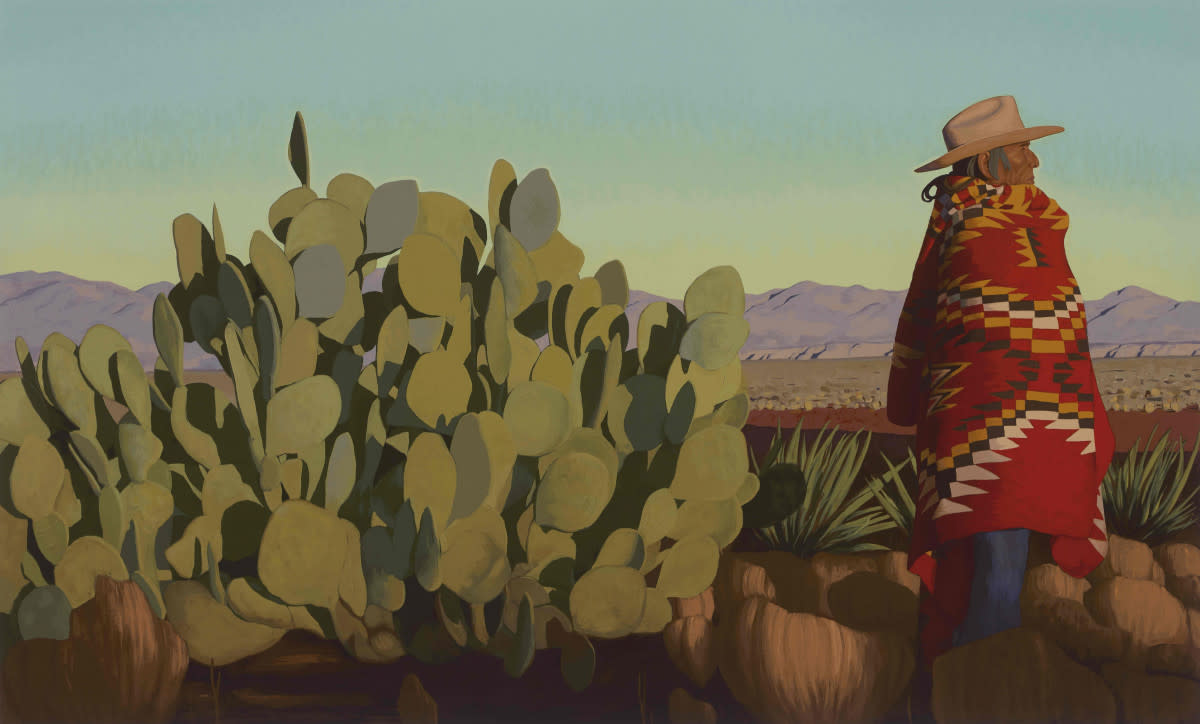
Was there a foundational memory from that landscape where this feeling clicked for you?
I remember this one road trip I took through the American West. I was just out of art school and I went with a friend to go and paint landscapes. We did a two-week trip through all these locations in the West, which I guess solidified it for me. I hadn’t yet realized that this subject spoke to me so much until this trip, so that might be the ‘moment’ in a sense. But I turned a corner after that. I was just so attracted to the simplicity of the desert. And it makes sense with the way my brain works and how I see things.
A big portion of painters of the American West strive for realism, but you take a more interpretive approach.
I remember in art school I was obsessed with being technically superior. I wanted to be able to paint like one of the old masters, and draw and paint as well as I could (which is still a goal). But there was a shift after art school where I had only studied classical realism. It just hit me that all the art I was attracted to wasn’t the most realistic or accurate—it was work that had a very clear and unique voice. I use Vincent Van Gogh as a common example because everyone knows who he is, but there’s no mistaking his work. He had his own weird way of painting; his own thing. I look at an artist like Georgia O’Keeffe, another American Western painter but just so iconic. The work is so her.
So after art school, I stopped painting for a while because I wasn't happy with the work I was doing. Then I slowly started creating these paintings out of my head—these really simplified versions of figures out in the landscape. Not necessarily Western figures either, just things that were very simple.
That got me back on the path of finding my own voice, where I started painting these big shapes and really powerful imagery. So the way something is drawn and painted isn’t always realistic (especially the landscapes and clouds) but I add a lot more detail to the figures. I give myself room to play, exaggerating certain things and simplifying others so it doesn’t look like a photo. I’m more interested in showing my view of the West. It's an image and a memory that is burned into my brain.

They also allude to a certain depth of storytelling but with a lot of ambiguity attached. How deep do these stories run for you?
It's not as deep as it may appear. When I really think about it, it’s probably closer to self-portraiture than anything. At least in the sense where these people are traveling, trying to find themselves or figure out where they’re going. But that’s part of it, going through life and figuring things out. I feel like I’m adding story after-the-fact, in a sense. I try not to overthink it because then it feels forced, so I just let the stories be.
Do these subjects exist in the same narrative world?
Yeah, I mean it starts to feel almost like a video game to me. There is this world I’ve created and all these people do exist within that world, but again I don’t go into what their stories are. These are real people I’m painting, so I do know their real life stories and who they are as people. So I don’t go much further within the paintings themselves.
Yeah, my interpretation looking through your work was that you substituted realism in the setting with like hyper-detailed elements in how your subjects are dressed and their facial expressions. What is your research process like for those elements?
The research involved in the paintings isn’t overly academic or detailed because that just kills it for me. It's linked to a region, so I'm not painting like Peruvian weavings on American Indians. The work is faithful to traditional weavings and blankets and figures. But a lot of times they are just from the people I meet up and do shoots with. They're painted how they're dressed.
Occasionally I will bring some of the blankets that I've collected over the years because I love the geometric design and patterns. In that sense, it's linked to the location but I’m not really trying to place the figures in any specific time. I'm not trying to paint them in the early 1900s. But besides just being linked to the culture and the location, that's as far as I go.
You’re also showing a time period that isn’t often depicted in American Western art, which is a more contemporary setting. That brings with it different commentary, different societal challenges, all the way to different outfits and detail. What challenges does that pose?
I had once thought about painting more historical scenes but I don’t have a connection to those times; it doesn’t feel natural to me. That time it is a different time and I’m definitely painting a certain perspective. There is a really sad reality to parts of American Indian culture, which is also true for any traditional culture in modern society. I’ve chosen to depict a brighter side of it.
I’ve gone to visit the Apache reservation in Arizona several times and there is a really sad reality to the things going on there. I’ve done some charity work with the elementary school there, where we donated money towards school uniforms from a print sale. These are little things the kids needed; like their school uniforms which cost $10, but some kids can’t afford it and are being bullied for what they wear to school. So to be able to help in that small way is nice. But it’s a part of the country that just gets ignored, because they’re not really seen that often by the general public. That being said, there is a huge amount of beauty and great things going on, if you take the time to look.
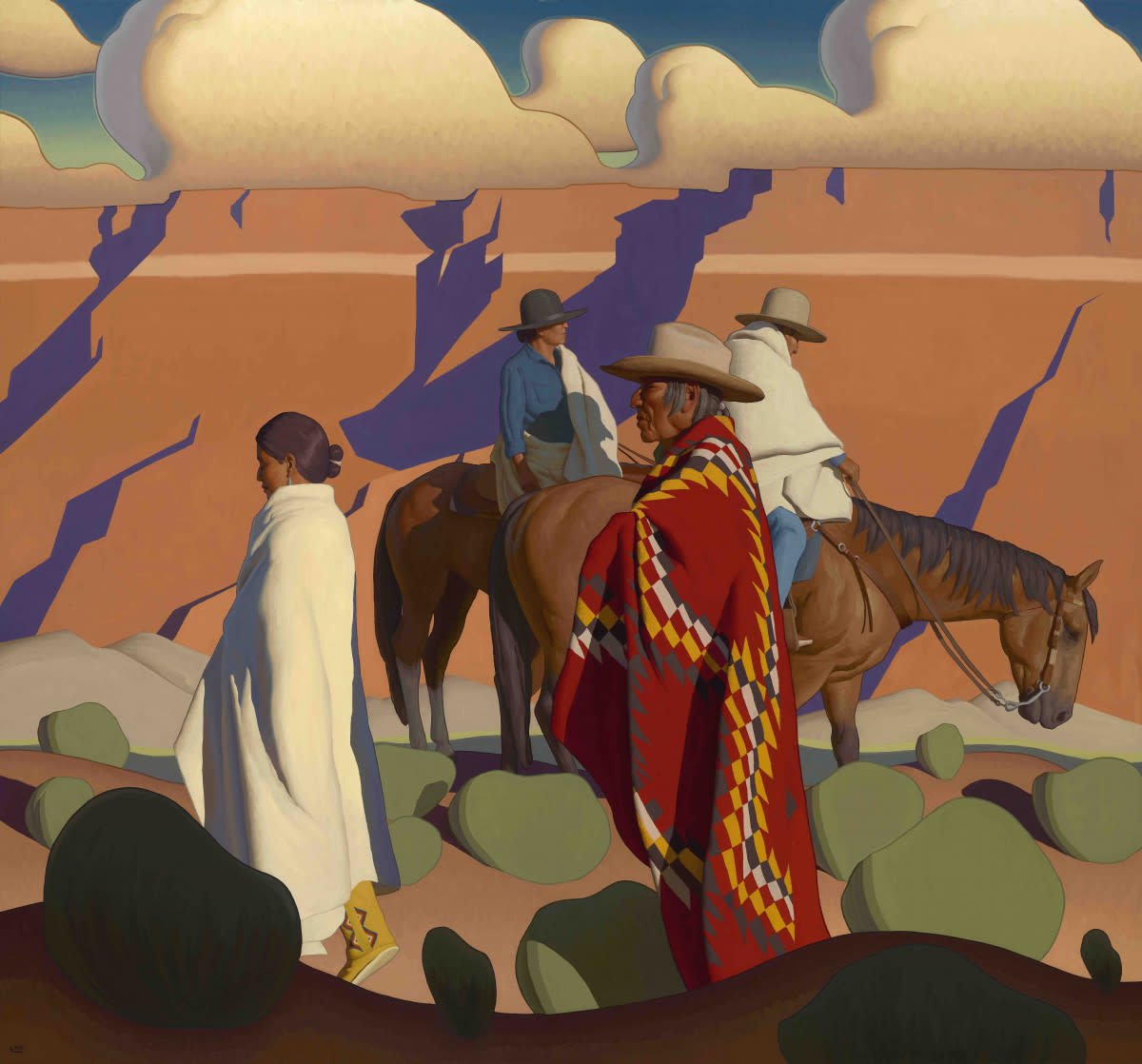
You talked earlier about wanting to be immersed in that landscape. What does it mean for your work to be completed on-site rather than in the studio?
I treat my time in the field, whether I’m out in the landscape or with the people I want to depict, as time to act as a sponge. I’m trying to gather ideas and references and memories but then I like to be back in California because I prefer to be removed from the subject. It allows for weird stuff to happen, where I’m having to make things up because I can’t just go run outside and look at what I’m working on. I do take photographs, but the memory of something comes into play a lot more than what I’m actually looking at.
It’s almost as though what I’m painting is the memory that is burned into my head. I like that space from the subject, it’s really helpful for me. I have a small house out in Arizona which is located in an area I paint all the time. So I’ll go out there and really immerse myself for a week, then come back to California and take that knowledge and experience I have into the studio.
So what ratio of memory to reference would you say your pieces are made of?
It’s hard to say. Probably like 40% from photos and 60% from memories. Generally, the people in my paintings are from photographs but the landscape and overall scene is my own. And then I’ll take people from different photographs and bring them together but the landscape from the clouds to the sky and the mountains are made up to strengthen and support the figure.
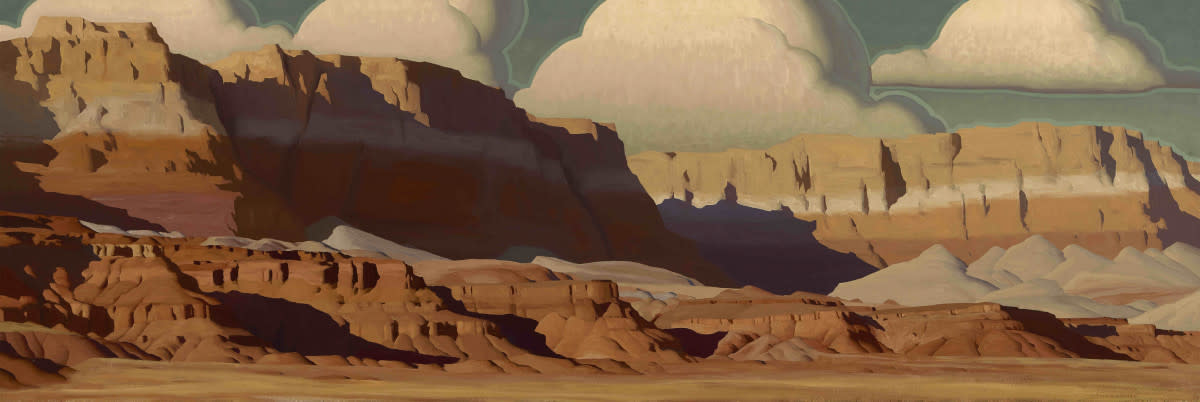
As someone who has studied this part of the world for so long, why do you think the American West has made a resurgence in pop-culture.
There are natural cycles in culture and style. I’ve definitely noticed in LA specifically a hipster trend of being into the West, wearing cowboy hats and Navajo jewelry. But I don’t know if that starts with fashion or from the movies, because I’ve definitely noticed a handful of films that have come out recently too.
I feel like I’m in the middle of all this but I have no part in it. I was doing this before it happened, I’m doing it in the middle of all that, and after it’s no longer fashionable I’ll still be doing it. I can’t analyse it too much because I’m pretty removed from those worlds. I mean, it’s cool to see the appreciation for something that I have a great love for but I’m not clear why it's happening.
You did an Instagram post recently recommending some of your favourite art movies. When I saw Hockney and Wyeth mentioned I thought 'yeah that makes sense', but Robert Crumb and Roy Lichtenstein were more surprising inclusions. How does the influence of the master impressionists differ from contemporary pop-art?
As far as the art movies go, I'll watch any movie on any artist, period. I just love the theme and subjects. I look at such a huge wide variety of art for inspiration. Roy Lichtenstein specifically has a strong influence on what I do because it’s just the simplicity and power of his images. Subject-wise we’re very different, but the visual idea behind our pieces are quite similar. Thomas Wilmer Dewing is someone you may not think is a major influence on me looking at my work, but his colour harmonies work their way into my paintings. They just sneak in there subconsciously.
As far as visual impact, it’s hard to say how these different influences find their way into my work. I love exposing myself to as much as possible. I’m not just into Western American art. I got started as a kid with comic books and cartoons, so that was the earliest influence on me.

What’s your day-to-day practice like?
I work in blocks of time, especially now with two kids at home. I usually start working in the morning, around 9 o’clock. I’ll work for a few hours, take a break around midday, work for a few more hours in the afternoon and then call it quits around five o’clock or so. I’ll spend the evening with my family and go back to the studio again at night, depending if I’m under deadline or not. That’s been my pattern lately, working in blocks of three-four hours. Today I started off with answering a bunch of emails and things I’d been lagging on, and then it’s back to painting.
Do you watch or listen to things while you’re working?
Oh yeah, it varies. Sometimes it’s audiobooks, I was on a real kick with Western American history, but that became a little depressing after a while and it felt like the state of the world right now called for something more silly to distract myself, so I switched over to listening to Howard Stern. I l listen to a lot of podcasts, some YouTube, often just background noise. I’ve been gardening a lot so listening to videos on YouTube about vegetable gardening tips or chicken coop ideas because I just built a chicken coop. Depends on the mood. I work in an intuitive way so I tend to turn my brain off from the painting I’m working on at anytime and rely on a sort of 'auto mode' which is why so many varieties of things might be playing in the studio while I work.
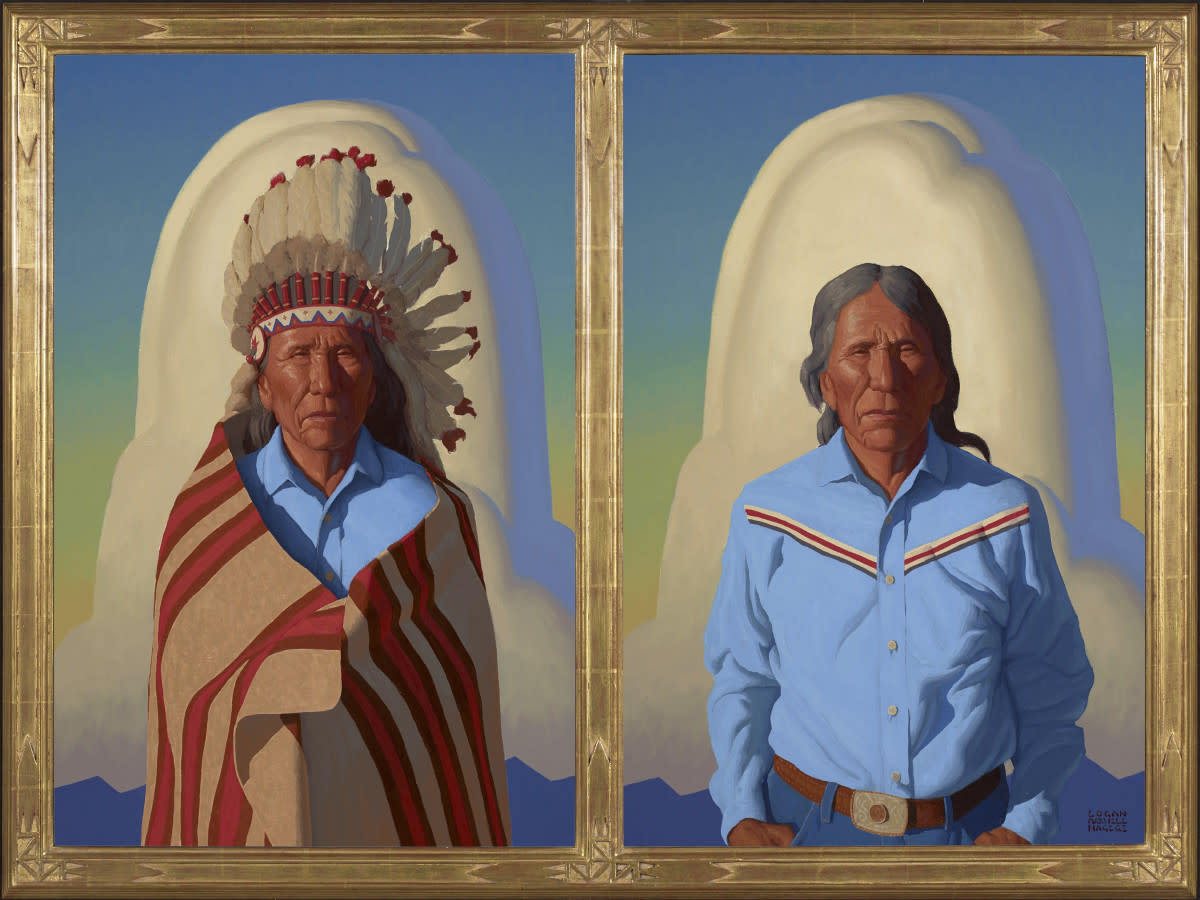
We're in an interesting moment where I feel the playing field is leveling for a lot of younger artists. What would you tell more emerging artists to help them get a foothold in the industry at such a turbulent time?
It always comes back to just training and working hard and being consistent. That’s always been a thing for me, just pushing forward and not thinking about plan B. I literally have no other skills besides what I do; I was always going to be an artist and that was the end of it. Early in my career when I was living check-to-check and barely making enough to live, I assumed that’s just how life was going to be. I never considered getting a second job. So working consistently, believing in yourself and moving forward is the best advice I can give.
There was a time when I was out in the public networking a lot more, which was helpful, but my work had to get to a certain level first. It doesn’t hurt to be out there and going to shows. Talking to other artists is important and meeting art collectors when you can.
The other thing is to try not to be too distracted by the craziness of the world. I have had some of my best times (business wise) when it seemed like the rest of the world was seemingly thrown off. So not letting yourself get caught up with what's going on in the world is important. Again, just put your best foot forward. You never know who's going to connect with what you do, so being able to show up is important.